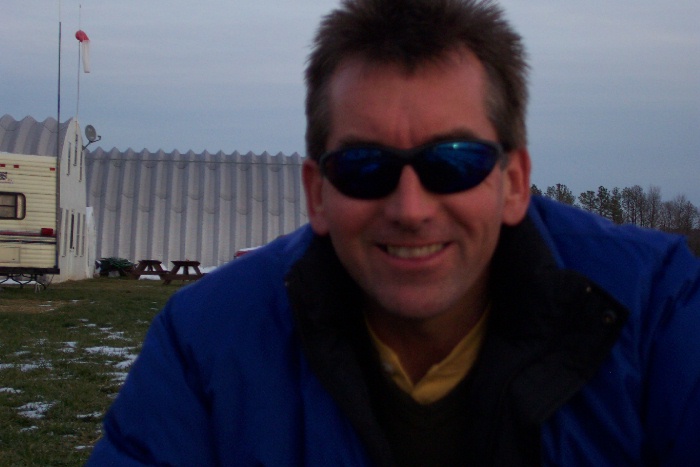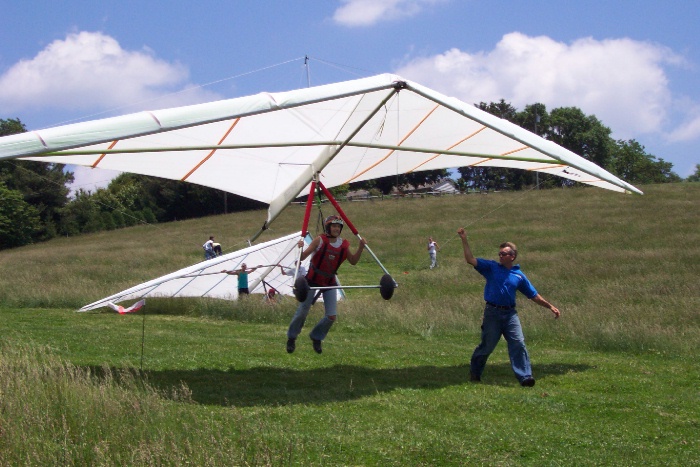|
Steve Wendt, 2004 USHGA Hang Gliding Instructor of the Year
By Billy Vaughn
|
|

|
Steve Wendt has been an instructor since he started flying in 1975. He had to be, because like
many who started that long ago, there was no one to teach him. Besides, the assembly instructions
that came with the glider kit he purchased had “how-to-fly” instructions on the back, and Steve’s
always been a do-it-yourself guy. His dad helped him in those first days by convincing his mom hang
gliding was safer than riding dirt bikes, and by offering constructive criticism and Band-Aids for
the bloody knuckles he got at the hill across the street from his house. So Steve has been an instructor
for 30 years, which makes him more than a marathoner. It’s more like an ultra, and he’s still running.
|
|
His years as an instructor have included managing Kitty Hawk Kites hang gliding school, as well as teaching
high school math and coaching wrestling. He started his own hang gliding school, Blue Sky, in 1991 and
finally quit teaching high school to run Blue Sky full time in 1998. Since he moved to Blue Sky flight
park in Manquin, Virginia, he’s been available just about every day, making him one of the hardest working
guys in hang gliding.
A typical day might start at 7:00, setting up for an early-morning scooter tow lesson that could run until
11:00 or noon, then truck towing his more experienced students through the soarable part of the day and
finally towing the new guys in the evening glass. All the while he’s available to help with harness and
equipment adjustments and rentals. Some days he even eats lunch. I’ve known Steve since he taught me my
first lesson in 1984, and I know tons of flying stories. Here’s my take on what keeps him teaching hang
gliding, and working so well with beginners, all these years.
One thing Steve mentioned is the challenge of teaching beginners, and of constantly adapting the way he
teaches. Different students have different ways of learning the same thing, and the constant challenge
of finding the best method for each student keeps Steve motivated. “Communication is the most important
thing in teaching,” he points out. “I remember one student who was having a hard time learning to launch,
and I kept telling her to ‘let the bar out’. She kept running and running but couldn’t get off the ground.
I finally realized that when I was saying let the bar out, she was actively trying to push the downtubes
away from each other, like a gymnast doing an iron cross. Sometimes you’ve got to really listen to yourself
and your students.”
|

|
Another thing that seems to keep Steve fresh is that he’s stayed busy, even though he keeps his teaching
load deliberately light. He’s a tinkerer, and there isn’t a lazy bone in his body. When he’s not cutting
the endless grass (or battling the dandelions with his homemade sprayer), he might be sewing sails or
training harnesses or bar mitts. Once while perfecting his sewing skills 20 years ago he built a foldable
chess set out of Dacron – just put on a pot of coffee and watch him go! More recently, Steve built his own
scooter towing system, and lately he’s been working on an oversized wheel system for his giant trainer,
affectionately known as The Colossus.
Even though the majority of Steve’s business revolves around the flight park, with scooter towing and platform
launching students, he hasn’t lost touch with the training hill. His connections with the community through
teaching high school helped him find a set of training hills, all on one piece of land, within a reasonable
walking distance from each other should the wind change. He mows just enough of the grass for safe “runways”
(with fabricated mower deck/ATV connection, of course), and leaves the rest for the farmer’s cows. During
the summer months Steve works with large groups, including youth adventure camps and 4H. And he still teaches
these kids Kitty Hawk-style, running alongside the glider, assisting on a wire if need be, occasionally
catching a student’s landing. And occasionally pulling a hamstring.
But all this misses what makes Steve a great instructor. Not only is he constantly innovating, but he’s got a
quality beyond the patience every instructor needs. It’s the same attribute that made him a great coach and
a great manager, a great boss. I call it the “beat me up some more” quality, and all born leaders seem to
have it. You just want to work hard and perform for the guy – you want to try really hard for him. It’s a
kind of precision motivation – he finds individual ways to make people want to perform. Many of Steve’s students
have had the experience of a less-than-perfect flight or landing and met with Steve’s perfectly gauged sarcastic
remark: “What’d you do that for?” But it’s not offensive, and it’s only delivered to the students who are ready
for it. The beauty of the remark is that the students love it, and can’t wait to try harder on the next flight.
Steve’s really careful with his students, and sometimes it can seem like he holds them back a bit, but I think
he’s looking for something almost intangible from them, some sort of subtle indication that they’re ready for
the next level, whether it be their first high-altitude platform tow, or their first tow into textured air. As a
wrestling coach, Steve learned how to motivate and read his wrestlers, when to push them and when to pull them – and
when to just let them be. I think he does the same sort of thing with hang gliding instruction, but it’s a
delicate balance. A new student came to Blue Sky years ago with an older, not so easy-to-fly glider he got a
“real deal” on. After careful explanation about how much longer it would take him to learn to fly it, and why
using Steve’s lower performing, easier-to-fly gliders might in fact be more economical in the long run, Steve
carefully let the guy beat his head against the wall for a while. Eventually the student saw the light, used
Steve’s gear, and he’s now a respected pilot with sound judgment and strong fundamental skills.
I asked Steve about the future of Blue Sky and the future of hang gliding. Like a lot of folks, Steve’s
convinced that the future of flight parks is the future of hang gliding. “I’d like to see Blue Sky grow
and have a full-time staff with multiple tugs and more amenities. As far as the future of hang gliding goes,
I think that gliders will get both faster and slower, that we’ll see progress at both ends of the performance
spectrum. I hope the manufacturers will put design energy into trainers to make them even lighter and slower
and easier to fly. Good trainers are key.”
And so are good instructors.
|
|
View Hang Gliding Magazine's Article PDF file "Steve Wendt Instructor of the Year"
|